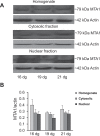Expression and subcellular localization of metastasis-associated protein 1, its short form, and estrogen receptors in rat placenta
- PMID: 25217305
- PMCID: PMC4812694
- DOI: 10.1177/1933719114549851
Expression and subcellular localization of metastasis-associated protein 1, its short form, and estrogen receptors in rat placenta
Abstract
Metastasis-associated protein 1 (MTA1) and its short form (MTA1s) regulate the function of estrogen receptors (ERs). Estrogens, via ERs, affect placental growth and fetal development, a process that may involve MTA1 signaling. Expression of MTA1, MTA1s, ERα, and ERβ genes and proteins in rat placentas was studied on 16, 19, and 21 days of gestation (dg). The ERβ messenger RNA decreased significantly toward the end of gestation, whereas its protein level increased in the nuclear fraction on 21 dg. Both MTA1 and MTA1s increased with gestation. Decidual, trophoblast giant, glycogen, and villous trophoblast cells expressed MTA1, ERα, and ERβ proteins on all dg with colocalization of MTA1 with ERα and ERβ in the nucleus and cytoplasm. Expression of MTA1 suggests a possible role in regulating placental functions; considering the repressive function of MTA1 on ERs, the expression of MTA1 suggests that placental cells may be less sensitive to estrogens during late pregnancy.
Keywords: MTA1; estrogen receptor alpha; estrogen receptor beta; estrogens; placental growth.
© The Author(s) 2014.
Conflict of interest statement
Figures









Similar articles
-
Carbenoxolone exposure during late gestation in rats alters placental expressions of p53 and estrogen receptors.Eur J Pharmacol. 2016 Nov 15;791:675-685. doi: 10.1016/j.ejphar.2016.09.035. Epub 2016 Sep 28. Eur J Pharmacol. 2016. PMID: 27693517
-
Rat uterine oxytocin receptor and estrogen receptor α and β mRNA levels are regulated by estrogen through multiple estrogen receptors.J Reprod Dev. 2014 Mar 7;60(1):55-61. doi: 10.1262/jrd.2012-139. Epub 2013 Dec 16. J Reprod Dev. 2014. PMID: 24334513 Free PMC article.
-
Ontogenic profile of estrogen receptor alpha and beta mRNA and protein expression in fetal rat brain.Neurosci Lett. 2008 Aug 8;440(3):222-6. doi: 10.1016/j.neulet.2008.05.061. Epub 2008 May 22. Neurosci Lett. 2008. PMID: 18571322
-
Estrogen receptor α and β in the normal immune system and in lymphoid malignancies.Mol Cell Endocrinol. 2013 Aug 15;375(1-2):121-9. doi: 10.1016/j.mce.2013.05.016. Epub 2013 May 23. Mol Cell Endocrinol. 2013. PMID: 23707618 Review.
-
Emerging roles of MTA family members in human cancers.Semin Oncol. 2003 Oct;30(5 Suppl 16):30-7. doi: 10.1053/j.seminoncol.2003.08.005. Semin Oncol. 2003. PMID: 14613024 Review.
Cited by
-
The effect of progesterone administration on the expression of metastasis tumor antigens (MTA1 and MTA3) in placentas of normal and dexamethasone-treated rats.Mol Biol Rep. 2022 Mar;49(3):1935-1943. doi: 10.1007/s11033-021-07005-5. Epub 2022 Jan 17. Mol Biol Rep. 2022. PMID: 35037193
-
The role of ACE2, angiotensin-(1-7) and Mas1 receptor axis in glucocorticoid-induced intrauterine growth restriction.Reprod Biol Endocrinol. 2017 Dec 29;15(1):97. doi: 10.1186/s12958-017-0316-8. Reprod Biol Endocrinol. 2017. PMID: 29321064 Free PMC article.
-
Physiological functions of MTA family of proteins.Cancer Metastasis Rev. 2014 Dec;33(4):869-77. doi: 10.1007/s10555-014-9514-4. Cancer Metastasis Rev. 2014. PMID: 25344801 Free PMC article. Review.
References
-
- Fonseca BM, Correia-da-Silva G, Teixeira NA. The rat as an animal model for fetoplacental development: a reappraisal of the post-implantation period. Reprod Biol. 2012;12 (2):97–118. - PubMed
-
- Bartholomeusz RK, Bruce NW, Lynch AM. Embryo survival, and fetal and placental growth following elevation of maternal estradiol blood concentrations in the rat. Biol Reprod. 1999;61 (1):46–50. - PubMed
-
- Manavathi B, Kumar R. Steering estrogen signals from the plasma membrane to the nucleus: two sides of the coin. J Cell Physiol. 2006;207 (3):594–604. - PubMed
Publication types
MeSH terms
Substances
LinkOut - more resources
Full Text Sources
Other Literature Sources
Molecular Biology Databases
Research Materials
Miscellaneous

